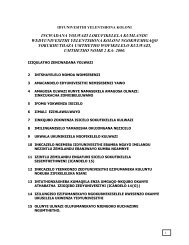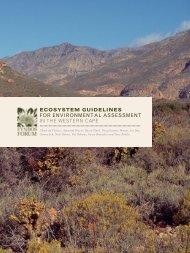Chapter 1 - University of the Western Cape
Chapter 1 - University of the Western Cape
Chapter 1 - University of the Western Cape
You also want an ePaper? Increase the reach of your titles
YUMPU automatically turns print PDFs into web optimized ePapers that Google loves.
<strong>Chapter</strong> 1<br />
The International Tourism Industry:<br />
Opportunities and Threats for Biodiversity Conservation<br />
1.1 The Growth <strong>of</strong> <strong>the</strong> International<br />
Tourism Industry<br />
Since <strong>the</strong> Second World War, <strong>the</strong><br />
growth <strong>of</strong> international tourism has<br />
been phenomenal. Annual tourist<br />
arrivals worldwide increased from<br />
25 million in 1950 to 450 million<br />
in 1990. Between 1969 and 1979,<br />
<strong>the</strong> World Bank encouraged developing<br />
countries to invest in tourism<br />
as a strategy for attracting foreign<br />
investment, and <strong>the</strong> governments <strong>of</strong><br />
developing countries began to see<br />
tourism as a means to redistribute<br />
resources from North to South.<br />
In <strong>the</strong> words <strong>of</strong> <strong>the</strong> World<br />
Tourism Organization (WTO),<br />
tourism became “one <strong>of</strong> <strong>the</strong> most<br />
important economic, social, cultural<br />
and political phenomena <strong>of</strong><br />
<strong>the</strong> twentieth century” (Ceballos-<br />
Lascurain 1996).<br />
Box 1: The World’s Biggest Industry?<br />
Today tourism is <strong>of</strong>ten described<br />
as <strong>the</strong> world’s “biggest” industry<br />
on <strong>the</strong> basis <strong>of</strong> its contribution<br />
to global gross domestic product<br />
(GDP), <strong>the</strong> number <strong>of</strong> jobs it generates,<br />
and <strong>the</strong> number <strong>of</strong> clients it<br />
serves (see Box 1). However, <strong>the</strong>se<br />
conclusions are based largely on<br />
arrivals statistics, which focus on<br />
international tourism and <strong>the</strong>refore<br />
hide <strong>the</strong> significance <strong>of</strong> domestic<br />
tourism. ese statistics may also<br />
underestimate regional tourists<br />
traveling by land ra<strong>the</strong>r than air<br />
or sea. e WTO estimates that<br />
<strong>the</strong> ratio <strong>of</strong> domestic to international<br />
tourism is as high as 10:<br />
1—although this varies hugely<br />
from country to country (WTO<br />
1997). e size <strong>of</strong> <strong>the</strong> industry<br />
and its rate <strong>of</strong> growth present both<br />
opportunities and threats for biodiversity<br />
conservation.<br />
Statistics produced by <strong>the</strong> World Travel and Tourism Council (WTTC) indicate that tourism<br />
generates 11 percent <strong>of</strong> global GDP, 3 employs 200 million people, and transports nearly<br />
700 million international travelers per year—a figure that is expected to double by 2020.<br />
According to <strong>the</strong> World Tourism Organization, international tourism<br />
• accounts for 36 percent <strong>of</strong> trade in commercial services in advanced economies and<br />
66 percent in developing economies;<br />
• constitutes 3–10 percent <strong>of</strong> GDP in advanced economies and up to 40 percent in<br />
developing economies;<br />
• generated US$464 billion in tourism receipts in 2001;<br />
• Is one <strong>of</strong> <strong>the</strong> top five exports for 83 percent <strong>of</strong> countries and <strong>the</strong> main source <strong>of</strong><br />
foreign currency for at least 38 percent <strong>of</strong> countries.<br />
Above: Walking tour through <strong>the</strong> rural villages <strong>of</strong><br />
Tuscany, Italy.<br />
Left: A wild cheetah adapts to <strong>the</strong> presence <strong>of</strong><br />
tourists by using a vehicle as a hunting lookout in<br />
Kenya’s Maasai Mara Game Reserve.<br />
“<br />
The tourism industry was<br />
considered by some to be a<br />
more reliable source <strong>of</strong> foreign<br />
exchange than minerals, raw<br />
materials, cash crops and<br />
manufactured goods, which had<br />
increasingly unstable prices.<br />
Tourism was also seen as an<br />
exceptional opportunity to valorize<br />
national culture, wildlife and<br />
”<br />
unique natural features.<br />
(Ghimire 1997).<br />
TOURISM AND BIODIVERSITY: MAPPING TOURISM’S GLOBAL FOOTPRINT<br />
1
At work building a rain forest canopy walkway<br />
for tourists in Ghana.<br />
The immense value <strong>of</strong> this<br />
vast resource remains largely<br />
unrecognized….Loss <strong>of</strong><br />
biodiversity results in serious<br />
reductions in <strong>the</strong> goods…and<br />
services…that <strong>the</strong> Earth’s<br />
ecosystems can provide and that<br />
make economic prosperity and<br />
human survival possible. In short,<br />
biodiversity is <strong>the</strong> very basis for<br />
”<br />
sustainable development.<br />
(WEHAB Working Group 2002).<br />
1.2 Biodiversity Considerations<br />
e Convention on Biological<br />
Diversity (CBD) defines biodiversity<br />
as “<strong>the</strong> variability among living<br />
organisms from all sources including,<br />
inter alia, terrestrial, marine<br />
and o<strong>the</strong>r aquatic ecosystems and<br />
<strong>the</strong> ecological complexes <strong>of</strong> which<br />
<strong>the</strong>y are part; this includes diversity<br />
within species, between species<br />
and <strong>of</strong> ecosystems” (CBD 1992).<br />
e common understanding <strong>of</strong> <strong>the</strong><br />
term “biodiversity” is all <strong>the</strong> living<br />
things on Earth and <strong>the</strong> ecological<br />
processes associated with <strong>the</strong>m.<br />
Vermeulen and Koziell (2002)<br />
note that, as such, biodiversity can<br />
be, and is, used as a synonym for<br />
“nature” or “life on Earth.” Often<br />
lost in discussions <strong>of</strong> biodiversity<br />
is <strong>the</strong> emphasis on <strong>the</strong> variability<br />
and variety within species, among<br />
species, and among <strong>the</strong> ecological<br />
processes, and <strong>the</strong> key benefits<br />
<strong>the</strong>se bring to humans in <strong>the</strong> form<br />
<strong>of</strong> choice—both in <strong>the</strong> present and<br />
in <strong>the</strong> future.<br />
Biodiversity is essential to<br />
human development because <strong>of</strong><br />
<strong>the</strong> goods and services it provides.<br />
Components <strong>of</strong> biodiversity may<br />
be used directly as food, medicine,<br />
building materials, and so<br />
on. Biodiversity provides more<br />
indirect benefits, in <strong>the</strong> form <strong>of</strong><br />
environmental regulation, soil<br />
conservation, and pollution control.<br />
It also has what economists<br />
refer to as “non-use values”—for<br />
example, <strong>the</strong> simple enjoyment or<br />
“existence value” <strong>of</strong> some aspects <strong>of</strong><br />
biodiversity and <strong>the</strong> option to use<br />
biological resources in <strong>the</strong> future.<br />
Many <strong>of</strong> <strong>the</strong> services biodiversity<br />
provides are not widely recognized<br />
or are not appropriately valued<br />
in economic terms. However,<br />
<strong>the</strong> combined economic value <strong>of</strong><br />
17 ecosystem services has been<br />
estimated at US$16.54 trillion<br />
per year (Costanza et al. 1997).<br />
Fur<strong>the</strong>rmore, one <strong>of</strong> <strong>the</strong> Working<br />
Groups for <strong>the</strong> World Summit on<br />
Sustainable Development (WSSD)<br />
reported that an estimated 40<br />
percent <strong>of</strong> <strong>the</strong> global economy is<br />
based on biological products and<br />
processes (WEHAB Working<br />
Group 2002).<br />
UNEP’s Global Environmental<br />
Outlook (GEO) report on <strong>the</strong><br />
state <strong>of</strong> <strong>the</strong> global environment<br />
(UNEP 2002) highlights that, on<br />
a global scale, biodiversity is being<br />
lost at a rate many times higher<br />
than that <strong>of</strong> natural extinction.<br />
is loss is due to land conversion,<br />
climate change, pollution,<br />
unsustainable harvesting <strong>of</strong> natural<br />
resources, and <strong>the</strong> introduction<br />
<strong>of</strong> invasive species. Human<br />
population growth, toge<strong>the</strong>r with<br />
unsustainable patterns <strong>of</strong> consumption,<br />
increasing production <strong>of</strong><br />
waste and pollutants, urban development,<br />
and international conflict,<br />
fur<strong>the</strong>r contributes to biodiversity<br />
loss. Over <strong>the</strong> past three decades,<br />
major losses <strong>of</strong> virtually every kind<br />
<strong>of</strong> natural habitat have occurred,<br />
and <strong>the</strong> decline and extinction<br />
<strong>of</strong> species have emerged as major<br />
environmental issues. Although<br />
insufficient information is available<br />
to determine precisely how many<br />
species have become extinct in <strong>the</strong><br />
past 3 decades, about 24 percent<br />
(1,130) <strong>of</strong> mammals and 12 percent<br />
(1,183) <strong>of</strong> bird species are currently<br />
regarded as globally threat-<br />
2 CHAPTER 1
ened. So great is <strong>the</strong> concern over<br />
<strong>the</strong> rate <strong>of</strong> decline, and its implications<br />
for human welfare, that<br />
biodiversity was identified as one <strong>of</strong><br />
<strong>the</strong> five priority areas for <strong>the</strong> 2002<br />
World Summit on Sustainable<br />
Development (WSSD). 4<br />
A common strategy for biodiversity<br />
conservation has been identify<br />
priority areas and focus conservation<br />
efforts on those areas. e<br />
international system <strong>of</strong> national<br />
and regional protected areas is a<br />
clear example <strong>of</strong> this approach, and<br />
it is also implemented through a<br />
variety <strong>of</strong> international agreements:<br />
<strong>the</strong> Ramsar Convention produces<br />
a list <strong>of</strong> Wetlands <strong>of</strong> International<br />
Importance, and <strong>the</strong> World<br />
Heritage Convention identifies sites<br />
<strong>of</strong> natural heritage considered to be<br />
<strong>of</strong> outstanding value. Several international<br />
conservation organizations<br />
have also adopted this strategy:<br />
BirdLife International designates<br />
Important Bird Areas (IBAs),<br />
based, inter alia, on <strong>the</strong> presence<br />
<strong>of</strong> globally threatened or endemic<br />
species; and World Wildlife Fund<br />
(WWF) has defined a “Global<br />
200” set <strong>of</strong> priority conservation<br />
areas, with <strong>the</strong> central concept<br />
being to conserve <strong>the</strong> broadest variety<br />
<strong>of</strong> <strong>the</strong> world’s habitats and <strong>the</strong><br />
most endangered wildlife.<br />
1.3 Conservation International’s<br />
Priority-Setting Mechanisms:<br />
Biodiversity Hotspots, Wilderness<br />
Areas, and Coral Reef Hotspots<br />
CI has developed a priority-setting<br />
strategy that focuses its attention<br />
on biodiversity hotspots around <strong>the</strong><br />
world. CI notes that two factors are<br />
considered for hotspot designation:<br />
“Hotspots are regions that harbor<br />
a great diversity <strong>of</strong> endemic species<br />
and, at <strong>the</strong> same time, have been<br />
significantly impacted and altered<br />
by human activities” (Meyers, et.<br />
al. 2000).<br />
Plant diversity is <strong>the</strong> biological<br />
basis for hotspot designation—to<br />
qualify as a biodiversity hotspot, a<br />
region must support at least 1,500<br />
endemic plant species (0.5 percent<br />
<strong>of</strong> <strong>the</strong> global total). Existing<br />
primary vegetation is <strong>the</strong> basis for<br />
assessing human impact in a region,<br />
and a hotspot must have lost 70<br />
percent or more <strong>of</strong> its original habitat.<br />
Overall, <strong>the</strong> hotspots have lost<br />
nearly 90 percent <strong>of</strong> <strong>the</strong>ir original<br />
natural vegetation.<br />
e biodiversity hotspots<br />
contain 44 percent <strong>of</strong> all known<br />
endemic plant species and 35 percent<br />
<strong>of</strong> all known endemic species<br />
<strong>of</strong> birds, mammals, reptiles, and<br />
amphibians in only 1.4 percent <strong>of</strong><br />
<strong>the</strong> planet’s land area (Meyers, et.<br />
al. 2000).<br />
Given <strong>the</strong> great concentration<br />
<strong>of</strong> plant and animal species in such<br />
a small and highly threatened terrestrial<br />
fragment <strong>of</strong> <strong>the</strong> world, it<br />
is extremely important that <strong>the</strong>se<br />
areas receive very special conservation<br />
attention, along with research<br />
and monitoring to prevent fur<strong>the</strong>r<br />
extinctions.<br />
Map 1 illustrates <strong>the</strong> location <strong>of</strong><br />
each <strong>of</strong> <strong>the</strong> hotspots. e biodiversity<br />
hotspots span countries <strong>of</strong> different<br />
sizes, economic and resource<br />
endowments, and social contexts.<br />
Mass tourism, as well as naturebased<br />
and adventure tourism, is<br />
a significant revenue generator in<br />
many <strong>of</strong> <strong>the</strong>se countries.<br />
CI has also identified 10 coral<br />
reef hotspots. Eight <strong>of</strong> <strong>the</strong> 10 are<br />
adjacent to terrestrial biodiversity<br />
hotspots. Extending terrestrial conservation<br />
efforts seaward in those<br />
places <strong>of</strong>fers an effective and affordable<br />
strategy for protecting global<br />
biodiversity. Coral reef hotspots,<br />
many <strong>of</strong> which receive significant<br />
tourism volumes, are also identified<br />
in Map 1.<br />
An additional and complementary<br />
terrestrial prioritization<br />
category used by CI is that <strong>of</strong> wilderness<br />
areas. ree major tropical<br />
wilderness areas are shown in Map 1<br />
—Amazonia, <strong>the</strong> Congo Forest<br />
<strong>of</strong> Central Africa, and <strong>the</strong> island<br />
<strong>of</strong> New Guinea. ey are at least<br />
70 percent intact and are generally<br />
under less pressure from encroaching<br />
human populations than are<br />
<strong>the</strong> biodiversity hotspots, having<br />
fewer than five people per square<br />
kilometer. As such, <strong>the</strong>se areas<br />
are among <strong>the</strong> last places where<br />
indigenous people can maintain<br />
traditional lifestyles. ese wilderness<br />
areas are among <strong>the</strong> largest<br />
remaining tracts <strong>of</strong> pristine land on<br />
Earth but, compared to similarly<br />
intact desert, arctic, or boreal<br />
regions, <strong>the</strong>y hold a high proportion<br />
<strong>of</strong> <strong>the</strong> planet’s biodiversity.<br />
ey are also <strong>of</strong> crucial importance<br />
to climate regulation and watershed<br />
protection.<br />
1.4 Tourism Development and<br />
Biodiversity Conservation: Linkages<br />
and Disconnects<br />
e travel and tourism industry<br />
claims that it is well placed to contribute<br />
to sustainable development<br />
on <strong>the</strong> grounds that it<br />
TOURISM AND BIODIVERSITY: MAPPING TOURISM’S GLOBAL FOOTPRINT<br />
3
• has less impact on <strong>the</strong> environment<br />
than many o<strong>the</strong>r industries,<br />
• is based on an enjoyment <strong>of</strong> <strong>the</strong><br />
natural and cultural environment<br />
and so is motivated to<br />
protect <strong>the</strong>m,<br />
• can play a positive role in<br />
awareness raising and consumer<br />
education through its vast<br />
distribution channels, and<br />
• provides an economic incentive<br />
to protect habitat that might<br />
o<strong>the</strong>rwise be converted to less<br />
environmentally friendly land<br />
uses (WTTC and IHRA 1999).<br />
e above points can be made<br />
equally in relation to tourism’s<br />
potential contribution to biodiversity<br />
conservation, because biodiversity<br />
is a critical component <strong>of</strong> <strong>the</strong><br />
natural environment that tourists<br />
enjoy. It is true, as this research<br />
project illustrates, that tourism has<br />
been growing and increasing particularly<br />
in biodiversity hotspots in <strong>the</strong><br />
South. Given <strong>the</strong> rapid growth in<br />
nature and adventure travel within<br />
<strong>the</strong> global tourism industry during<br />
<strong>the</strong> past 2 decades, it is reasonable<br />
to assume that tourism’s growth<br />
in <strong>the</strong>se high biodiversity areas is<br />
linked to <strong>the</strong>ir relatively unique<br />
natural environments. Destroying<br />
<strong>the</strong> environment on which <strong>the</strong><br />
success <strong>of</strong> <strong>the</strong> industry is based is<br />
<strong>the</strong>refore like killing <strong>the</strong> goose that<br />
lays <strong>the</strong> golden egg.<br />
Tourism can, and sometimes<br />
does, make significant contributions<br />
to protected-area systems <strong>of</strong> conservation.<br />
Direct benefits from tourism<br />
to conservation can be clustered in<br />
five areas (Brandon 1996):<br />
1. a source <strong>of</strong> financing for biodiversity<br />
conservation, especially<br />
in legally protected areas;<br />
2. economic justification for protected<br />
areas;<br />
3. economic alternatives for local<br />
people to reduce overexploitation<br />
<strong>of</strong> wildland and wildlife<br />
resources on protected areas;<br />
4. constituency-building, which<br />
promotes biodiversity conservation;<br />
and<br />
5. an impetus for private biodiversity<br />
conservation efforts.<br />
In <strong>the</strong> South, tourism is <strong>of</strong>ten <strong>the</strong><br />
overriding justification for governments<br />
to support <strong>the</strong> creation <strong>of</strong><br />
new protected areas. In addition,<br />
since <strong>the</strong> mid-1980s, <strong>the</strong> trend<br />
toward wildlife needing to “pay its<br />
way” and for local communities to<br />
be actively involved in conservation<br />
efforts has led to <strong>the</strong> emergence <strong>of</strong><br />
ecotourism as a more responsible<br />
form <strong>of</strong> nature-based travel that<br />
promotes biodiversity conservation<br />
and also brings benefits to<br />
local communities (see Box 2).<br />
During <strong>the</strong> seventh session <strong>of</strong> <strong>the</strong><br />
United Nations Commission on<br />
Sustainable Development (CSD)<br />
in 1999, UNEP reemphasized<br />
<strong>the</strong> growing recognition that “<strong>the</strong><br />
involvement <strong>of</strong> local communities<br />
in tourism development and operation<br />
appears to be one important<br />
condition for <strong>the</strong> conservation and<br />
sustainable use <strong>of</strong> biodiversity.”<br />
Obligations <strong>of</strong> donors and governments<br />
under <strong>the</strong> CBD, with its<br />
emphasis on sustainable use and<br />
benefit sharing, have served to<br />
reinforce this trend, resulting in<br />
Box 2: Ecotourism—Linking Tourism and Biodiversity Conservation<br />
“Ecotourism is an idea, a concept, that is challenging tourism as<br />
we have known it. Defined most succinctly as ‘responsible travel<br />
to natural areas, that conserves <strong>the</strong> environment and sustains <strong>the</strong><br />
well being <strong>of</strong> local people,’ ecotourism fundamentally reshapes<br />
<strong>the</strong> basic precepts behind tourism, which is quite simply travel<br />
undertaken for pleasure. Nature tourism, which is frequently but<br />
erroneously considered <strong>the</strong> same as ecotourism, is defined as<br />
travel to unspoiled places to experience and enjoy nature. Its close<br />
cousin, adventure tourism, is described as nature tourism with<br />
a kick—nature tourism with a degree <strong>of</strong> risk taking and physical<br />
endurance. Nature and adventure tourism focus on what <strong>the</strong><br />
tourist is seeking. In contrast, ecotourism is qualitatively different.<br />
It focuses on what <strong>the</strong> traveler does, plus <strong>the</strong> impact <strong>of</strong> this<br />
travel on both <strong>the</strong> environment and <strong>the</strong> people in <strong>the</strong> host country.<br />
Ecotourism posits that this impact should be positive. Ecotourism<br />
is not, <strong>the</strong>refore, simply ano<strong>the</strong>r niche market within <strong>the</strong> tourism<br />
industry. Ra<strong>the</strong>r, ecotourism is a philosophy, a set <strong>of</strong> practices<br />
and principles that, if properly understood and implemented, will<br />
transform <strong>the</strong> way we travel.”<br />
(Honey 2002)<br />
4 CHAPTER 1
Map 1: Hotspots, Major Tropical Wilderness Areas, and Coral Reef Hotspots<br />
California Floristic Province<br />
Caribbean<br />
Mesoamerica<br />
Chocó-Darién-<strong>Western</strong> Ecuador<br />
Amazonia<br />
Tropical Andes<br />
Polynesia/Micronesia<br />
Central Chile<br />
Guinean Forests<br />
<strong>of</strong> West Africa<br />
Brazilian Cerrado<br />
Atlantic Forest Region<br />
Mediterranean Basin<br />
Succulent Karoo<br />
Congo<br />
Forest<br />
Caucasus<br />
<strong>Western</strong> Ghats & Sri Lanka<br />
Eastern Arc Mts &<br />
Coastal Forests <strong>of</strong><br />
Tanzania & Kenya<br />
<strong>Cape</strong> Floristic Region<br />
Madagascar & Indian<br />
Ocean Islands<br />
contribute to conservation and<br />
community development in <strong>the</strong><br />
areas being developed.<br />
It might be expected that<br />
tourism development following<br />
<strong>the</strong> principles associated with<br />
ecotourism would go hand in hand<br />
with biodiversity conservation and<br />
improvements in rural livelihoods.<br />
In many instances, tourism has<br />
been instrumental in delivering<br />
scarce funds for conservation<br />
and providing local people with<br />
an economic incentive to protect<br />
biodiversity from o<strong>the</strong>r, potentially<br />
more damaging forms <strong>of</strong> develop-<br />
Indo-<br />
Burma<br />
Mountains <strong>of</strong><br />
Southwest China<br />
Sundaland<br />
Southwest<br />
Australia<br />
Philippines<br />
Wallacea<br />
Polynesia/Micronesia<br />
New Guinea<br />
New Zealand<br />
New Caledonia<br />
BIODIVERSITY HOTSPOTS, MAJOR TROPICAL WILDERNESS AREAS, AND CORAL REEF HOTSPOTS<br />
Hotspots<br />
Open water<br />
Major Tropical Wilderness Areas No data for study year<br />
Coral Reef Hotspot Areas<br />
Scale: 1/190,000,000<br />
Projection: Robinson<br />
Data: Conservation International 2002<br />
Cartography: M. Denil<br />
© CI 2003<br />
<strong>the</strong> CBD Guidelines on Sustainable<br />
Tourism in Vulnerable Ecosystems,<br />
approved in <strong>the</strong> convention’s<br />
Scientific and Technical advisory<br />
body in March 2003.<br />
Communities that receive<br />
significant income from tourism<br />
may be motivated to conserve biodiversity.<br />
However, if benefits are<br />
small—or not sufficiently linked<br />
with conservation inputs—<strong>the</strong>y<br />
may be reinvested in activities that<br />
undermine biodiversity conservation<br />
such as livestock rearing<br />
(WCPA 2000).<br />
Sustainable tourism has<br />
emerged as a more responsible form<br />
<strong>of</strong> mass tourism development (see<br />
Box 3). In <strong>the</strong> past, traditional<br />
mass tourism developments have<br />
been a major threat to biodiversity<br />
conservation because management<br />
controls and effective planning<br />
mechanisms have been lacking.<br />
Drawing from <strong>the</strong> concepts <strong>of</strong><br />
ecotourism, namely that tourism<br />
should “conserve <strong>the</strong> environment<br />
and sustain <strong>the</strong> well-being <strong>of</strong> local<br />
people” (TIES 1991), sustainable<br />
tourism seeks to minimize<br />
<strong>the</strong> negative footprint <strong>of</strong> tourism<br />
developments and at <strong>the</strong> same time<br />
TOURISM AND BIODIVERSITY: MAPPING TOURISM’S GLOBAL FOOTPRINT<br />
5
Box 3: Sustainable Tourism and Biodiversity Conservation<br />
Sustainable tourism (which draws on <strong>the</strong> principles <strong>of</strong> ecotourism) can directly contribute<br />
to biodiversity conservation by:<br />
• <strong>of</strong>fering less destructive livelihood alternatives to local communities and landowners<br />
in buffer zones and conservation corridors, away from unregulated logging, intensive<br />
cattle-ranching, monoculture, hunting, and unsustainable tourism;<br />
• providing an incentive for public and private landowners in critical ecosystems to<br />
permanently conserve biodiversity-rich properties, by <strong>of</strong>fering revenue-producing,<br />
low-impact economic use;<br />
• providing protected-area managers with additional financial resources from visitation<br />
and donations; and<br />
• raising visitor awareness, promoting community involvement and interest in conservation<br />
issues, and generating political support for conservation through environmental<br />
education during travel.<br />
Atlantic Forest, Brazil.<br />
The role <strong>of</strong> tourism in<br />
biodiversity conservation<br />
is especially significant in<br />
Sou<strong>the</strong>rn nations because<br />
many Sou<strong>the</strong>rn nations have<br />
particularly rich biodiversity<br />
but…protected area agencies<br />
with few funds and little<br />
political power. Nor<strong>the</strong>rn<br />
tourism can provide incentives<br />
to conserve biodiversity<br />
through foreign exchange and<br />
economic opportunities for<br />
Sou<strong>the</strong>rn governments and<br />
”<br />
local communities.<br />
(Buckley 2002)<br />
ment such as mining, logging,<br />
or consumptive use <strong>of</strong> wildlife.<br />
Maintaining an attractive resource<br />
base has in turn continued to<br />
attract more tourists and support<br />
a healthy tourism industry,<br />
thus generating more funds for<br />
conservation. A mutually supporting<br />
circle <strong>of</strong> success can develop.<br />
However, this positive relationship<br />
is not always <strong>the</strong> case, particularly<br />
where tourism development occurs<br />
without management standards<br />
and guidelines that seek to promote<br />
conservation <strong>of</strong> nature and<br />
deliver tangible benefits to local<br />
communities.<br />
Moreover, whatever <strong>the</strong> form<br />
<strong>of</strong> tourism developed, infrastructure<br />
and facilities for <strong>the</strong> tourism<br />
industry usually require significant<br />
tracts <strong>of</strong> land and building<br />
materials. Tourism development<br />
regularly takes place in a rapid<br />
and unplanned manner, resulting<br />
in total landscape transformation<br />
in a very short period <strong>of</strong> time,<br />
<strong>of</strong>ten leading to deforestation<br />
and drainage <strong>of</strong> wetlands. Such<br />
habitat disruption can result in<br />
significant loss <strong>of</strong> biodiversity.<br />
e problem is exacerbated by <strong>the</strong><br />
fact that a lot <strong>of</strong> tourism occurs in<br />
fragile areas (e.g., coastal zones,<br />
mountains, protected areas) or<br />
areas <strong>of</strong> high biodiversity.<br />
e very nature <strong>of</strong> <strong>the</strong> mainstay<br />
product <strong>of</strong> <strong>the</strong> tourism industry—sand,<br />
sea, and sun—highlights<br />
<strong>the</strong> fact that <strong>the</strong> industry is<br />
very dependent on coastal areas.<br />
Alongside increasing urbanization<br />
and industrialization, UNEP’s<br />
Global Environment Outlook<br />
(GEO) report notes that uncontrolled,<br />
mass tourism is one <strong>of</strong><br />
<strong>the</strong> root causes behind coastal<br />
degradation today (UNEP 2002).<br />
As well as its direct environmental<br />
impacts, resource depletion can<br />
also have indirect socioeconomic<br />
effects, as essential resources<br />
become scarce for local people.<br />
e World Conservation Union<br />
6 CHAPTER 1
(IUCN) notes that this can, in<br />
turn, have additional negative<br />
impacts on biodiversity, by concentrating<br />
local resource use in smaller<br />
areas and/or by undermining local<br />
resource management systems<br />
(WCPA 2000).<br />
In addition to resource depletion<br />
and habitat disruption, littering<br />
and water pollution are problems<br />
associated with mainstream<br />
tourism that can have negative<br />
consequences for biodiversity conservation.<br />
e littering problem is<br />
exacerbated in remote areas, where<br />
waste collection can be logistically<br />
difficult (e.g., on mountains, in<br />
<strong>the</strong> middle <strong>of</strong> <strong>the</strong> ocean). Waste<br />
disposal from cruise ships has<br />
been problematic, as <strong>the</strong>y have<br />
limited capacity to carry all <strong>the</strong>ir<br />
waste until <strong>the</strong>y reach <strong>the</strong>ir home<br />
port, and destination ports have<br />
limited incentive (and capacity) to<br />
accommodate periodic discharges.<br />
However, “most <strong>of</strong> <strong>the</strong> major cruise<br />
lines have begun to implement<br />
comprehensive waste management<br />
programs and wastes such as glass,<br />
Box 4: Tourism’s Resource Consumption<br />
cardboard, aluminum and steel<br />
cans are processed onboard through<br />
crushing, reuse and/or recycling<br />
and incineration” (Sweeting &<br />
Wayne 2003). Construction <strong>of</strong><br />
hotels, recreation, and o<strong>the</strong>r facilities<br />
<strong>of</strong>ten leads to increased sewage<br />
pollution. Wastewater has polluted<br />
seas and lakes surrounding tourist<br />
attractions, damaging <strong>the</strong> flora and<br />
fauna.<br />
Coral reefs are at a particular<br />
risk from unplanned tourism development.<br />
Holden (2000) notes that,<br />
as well as being mined for building<br />
materials, reefs suffer from sewage<br />
run<strong>of</strong>f that stimulates <strong>the</strong> growth<br />
<strong>of</strong> algae, covering <strong>the</strong> filter-feeding<br />
corals and hindering <strong>the</strong>ir ability to<br />
survive. In addition, reefs are <strong>of</strong>ten<br />
damaged by <strong>the</strong> activities <strong>of</strong> careless<br />
tourists—as divers and snorkelers<br />
kick and stand on coral, for example,<br />
or boats and jet skis scrape <strong>the</strong><br />
surface <strong>of</strong> <strong>the</strong> reef. Fur<strong>the</strong>rmore,<br />
dive/snorkel boat operators may<br />
throw <strong>the</strong>ir anchors into corals, and<br />
local entrepreneurs <strong>of</strong>ten break <strong>of</strong>f<br />
pieces <strong>of</strong> coral to sell as souvenirs.<br />
Using consumption averages from various countries, statistics from WTO, and estimates <strong>of</strong><br />
national tourism in relation to international arrivals, UNEP proposed some estimates <strong>of</strong> <strong>the</strong><br />
order <strong>of</strong> magnitude <strong>of</strong> resource consumption from tourism.<br />
If <strong>the</strong> global tourism industry were represented as a country, it would consume resources at<br />
<strong>the</strong> scale <strong>of</strong> a nor<strong>the</strong>rn developed country.<br />
International and national tourists use 80 percent <strong>of</strong> Japan’s yearly primary energy supply<br />
(5,000 million kWh/year), produce <strong>the</strong> same amount <strong>of</strong> solid waste as France (35 million<br />
tons per year), and consume three times <strong>the</strong> amount <strong>of</strong> fresh water contained in Lake<br />
Superior, between Canada and <strong>the</strong> United States, in a year (10 million cubic meters).<br />
Mountains are also popular<br />
locations for tourism and, because<br />
<strong>of</strong> <strong>the</strong>ir fragile soils, <strong>the</strong>y are particularly<br />
sensitive to environmental<br />
impacts. Deforestation from tourism<br />
(through construction, use <strong>of</strong><br />
wood for fires, etc.) can have direct<br />
implications for habitat conservation<br />
and watershed management<br />
and can also increase <strong>the</strong> likelihood<br />
<strong>of</strong> landslides.<br />
It is <strong>the</strong>se negative impacts <strong>of</strong><br />
unmanaged tourism development<br />
on <strong>the</strong> environment and local cultures<br />
that gave rise to ecotourism in<br />
<strong>the</strong> 1980s and 1990s as an alternative<br />
set <strong>of</strong> principles and practices<br />
to harness tourism’s economic<br />
potential for biodiversity conservation<br />
and sustainable development.<br />
During <strong>the</strong> last decade, ecotourism<br />
has emerged from small model<br />
projects demonstrating how tourism<br />
can be a catalyst for conserving<br />
nature and promoting <strong>the</strong> wellbeing<br />
<strong>of</strong> local peoples into a wider<br />
set <strong>of</strong> sustainable tourism principles<br />
that can be applied across a larger<br />
segment <strong>of</strong> <strong>the</strong> travel and tourism<br />
industry. However, just how far,<br />
and to what degree, <strong>the</strong>se principles<br />
will ultimately be able to transform<br />
<strong>the</strong> mass tourism industry to be a<br />
more positive force for biodiversity<br />
conservation remains to be seen.<br />
Endnotes<br />
3<br />
e WTTC commonly quotes this figure, although <strong>the</strong> WTO<br />
puts <strong>the</strong> figure lower. e difference reflects <strong>the</strong> difficulty<br />
in defining what is and is not included within <strong>the</strong> tourism<br />
“industry” and whe<strong>the</strong>r services such as transport are included<br />
in <strong>the</strong> calculation. e WTTC figure also incorporates <strong>the</strong><br />
multiplier effect <strong>of</strong> tourism spending and <strong>the</strong>refore reflects <strong>the</strong><br />
economic impact <strong>of</strong> <strong>the</strong> wider “tourism economy” ra<strong>the</strong>r than just<br />
<strong>the</strong> industry itself.<br />
4<br />
WSSD focused on water, energy, health, agriculture, and<br />
biodiversity (WEHAB Working Group 2002).<br />
TOURISM AND BIODIVERSITY: MAPPING TOURISM’S GLOBAL FOOTPRINT<br />
7
















